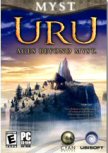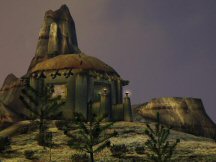You find
yourself in an alien, perplexing world. You don’t really know why
you are here or what it is you are supposed to be doing. There is a
large area to explore -- though eventually you can go no further
unless you can unlock a door that has no key. You take a closer look
at the environment and begin to see patterns, clues. You find a
letter with a vaguely alarming message. Suddenly, you see the
pattern a different way. Ahhh! That's how the power operates! There
is a grinding noise, and a door opens, leading to a place that is
not at all what you expected….
This is Uru. Okay, this could also be a description of Myst; in many
ways Uru continues Myst’s traditions. But it is also something
completely different.
In Uru (I will be describing the stand-alone game only, without the
online Uru Live component), the adventure begins in the American
southwest. You are initially assisted by a character named Zandi who
sits in the shade of his trailer home, patiently answering
questions. There’s also a message from Yeesha, who is a descendent
of the D’ni. The D’ni are a race who have lived secretly for
centuries in caverns beneath the earth. Yeesha offers a quest that
cannot be refused; a journey whose purpose and dangers are hidden.
The story weaving its way through Uru resonates with history from
the Myst games and books. You receive periodic explanations from
Yeesha as she fills in the background to the journey/quest. Further,
you stumble across journals that provide glimpses into the minds of
the archaeologists and researchers who are also exploring the
various D’ni Ages. These scientists are members of the D’ni
Restoration Council (DRC), and their methods are very different from
those of Yeesha. The DRC is proceeding cautiously, carefully
following rules and procedures. Yeesha, on the other hand, is past
the stage of following other people’s rules. She acts from the
heart, with insight and passion. Uru sows the seeds of this looming
conflict, but leaves it unresolved. Overall, I would have liked the
story to be a bit more fleshed-out -- I'm assuming the plotline
develops further in the online Uru Live portion of the game.
There are five ages to explore in Uru, plus glimpses of the
mysterious city beneath the earth. There’s an introductory age that
accustoms the player to Uru’s controls and style of gameplay. The
game can be played with either the mouse or the keyboard, and you
choose to explore from either the first person or third person
perspective. I liked this flexibility a lot. Third person lends
itself to positioning your avatar with precision. First person gives
a closer, more intimate view of the surroundings.
The four major Ages in Uru are considerably larger than the
introductory Age. You link to these from your personal age -– Relto
-- where you keep a collection of linking books. Relto also allows
you to change the appearance of your avatar whenever you like. In
the four major Ages you will encounter giant organic structures,
ravishingly beautiful landscapes, dark passages, ancient
technological marvels, secret chambers, huge engines, hidden
staircases, sumptuous gardens, and paths that wind impossibly high
with nothing but mist below.
Where Uru truly shines and delights is in the immersive quality of
these worlds. The Ages in Uru are gorgeous. From every angle the
place is breathtaking. In 3D, the worlds come alive in ways they
didn’t in the 2D Myst world. Everything that moves in the game is
glorious to watch – rippling water, swirling clouds, the pattern of
light and shadow as you stand on a moving platform, fish moving
through the water, “snow” falling.
Ambient sounds in Uru are amazingly realistic. The New Age music is
beautiful and appropriate in each Age. One place in particular – the
shrine on D’ni – features a single clear voice rising above the
cadence of a drum. It is both spiritual and alluring. I thought the
music in this game suited it perfectly.
Some of the challenges in Uru would fit comfortably into any
previous Myst game. These include mechanical puzzles and pattern
puzzles. A few are simple if you observe your surroundings with
care. Others are multi-stepped and tough. In the toughest puzzles, I
could identify the salient clue(s) and get a sense of where the
puzzle was leading, but had difficulty making the final connection
to the solution. I thought Uru’s hardest puzzles were more difficult
than those in the previous Myst games.
Many of the challenges in Uru incorporate movement. A few are
actually observation challenges: what happens when you (or objects
in the environment) move? These challenges are a lot of fun. In
fact, they are ingenious. However, there are physical challenges in
the game that require timing and skill and these are more difficult.
Uru took me about sixty hours to complete; I estimate that I spent
five of those hours jumping. To be more accurate, I spent five hours
jumping, falling and then waiting for the Age to reload after I’d
missed the landings. I spent the longest time on a series of jumps
that could have been avoided altogether if I had explored a bit more
before charging ahead. Of the challenges that are necessary to
progress, it took me about twenty attempts to beat the hardest jump.
For the most part I enjoyed jumping, though I never did feel
completely comfortable doing it.
Still, I was an expert jumper when compared to the total
incompetence I demonstrated while pushing things. The places in the
game where you have to push things were frustrating in the extreme;
not only because the process itself is awkward, but also because
many pushable objects are NOT part of puzzle solutions. I spent a
long time trying to push packing foam onto an elevator without
success. More time trying to push a bone into a hole without
success. Even more time trying to push a cone through a gap in the
rocks without success. All these futile endeavors turned out to have
absolutely no relevance to the game.
I know there are Myst aficionados who will be wondering if the 3D
graphics in Uru rival the 2D graphics in Riven. Uru has more
realistic water effects, and does a much better job with wind,
clouds, mist and drifting leaves. You can stand in the rain, watch
the sun set and see the stars come out. Uru’s underground
environments are more weighty and monumental and the air is full of
dust. Critters are more fun to watch in Uru because they approach
you, even buzz around you. Animations are integrated into the
environment much more seamlessly. Riven, on the other hand, has more
realistic sunlight effects, and does a much better job with
reflective surfaces, subtly blended shapes, mottled effects, and
gradations in shadows. Uru is more kinesthetic, more of a balanced
experience. Uru flows. You always know where your body is in space.
Riven is intensely visual, with objects and vistas honed to
photorealistic perfection, but Riven can give the player a
surprising experience of disorientation and jerkiness with the
simple act of turning around.
Is Uru a genuine sequel to Myst? Well, there are things about Uru
that are so entirely new that it feels more like an off-shoot than a
sequel. It’s as though Myst had the potential to split in two paths.
One is detail-intensive, intricately beautiful and contemplative.
The other is experimental, spectacularly beautiful and full of
movement. Uru embodies the second path. Since finishing the game,
I’ve been re-exploring the worlds, noticing some of the little
things I missed the first time around. The game is fascinating,
visually and auditorially entrancing, occasionally bewildering,
absorbing, mysterious and deep. I like it so much that I can’t wait
to see what lies ahead on this particular path!
Quick List for Uru (CD game only, without the online Uru Live
component)
Jaw-dropping, haunting 3D environments. Ability to switch between
1st person and 3rd person perspectives and to customize your avatar.
The game autosaves and gives you access to one in-game save point in
each Age. No sliding tile puzzles, no sound puzzles, no mazes, three
fairly forgiving timed puzzles, a handful of difficult jumping
challenges and logic puzzles. Mechanical puzzles, pattern puzzles,
exploration and observation. You cannot die, but if you fall, you
link back to your “home” Age (Relto) and must re-link to where you
were playing. Load times are long. Two minor glitches in which the
avatar sank through a solid surface and then linked back to Relto.
The game was stable, except when the graphics settings were cranked
up to maximum. The quality of the graphics at the lowest settings
when compared to the highest settings was so different that it
almost seemed like a different game. Terrific music and voice
acting. Not a lot of story, though what’s there is intriguing. Game
length: long. Aimed at gamers who like to explore gorgeous, surreal
environments while solving a wide range of puzzle and movement
challenges.
Final Grade: A
Reviewer’s system specs: Windows XP, Pentium 4 1.8 GHz with 512 MB
Ram, a 64MB Geforce 3 video card, Direct X 8.1, and a Sound Blaster
Live sound card. Graphics settings: Overall quality and texture --
High; Anti-aliasing -- Medium; 32 bit color depth; 1024x768 screen
resolution.
12-2005
design copyright ©
2004
GameBoomers
Group

